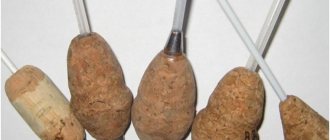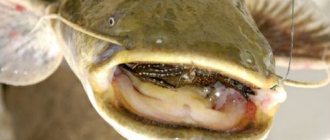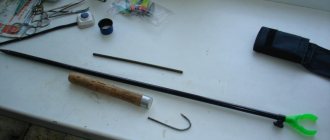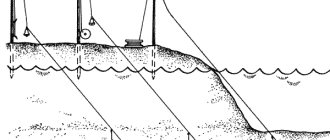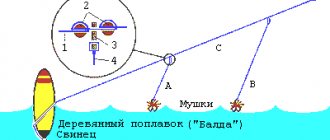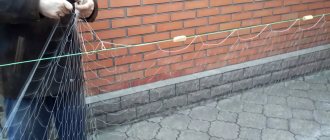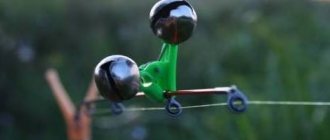Raising the topic of floats, I would like to start with my daughter’s favorite cartoon “Masha and the Bear”, and the words - “Does it bite like this?”, where Masha catches a piece of branch, rope and a pine cone, and she comes across a goldfish. In real fishing, luck often turns its back, and most often this is due to the wrong choice of equipment.
The float is your eyes, with which you watch the behavior of the fish, and choose the right moment when biting. But, like incorrectly selected glasses, an incorrectly selected float can distort the picture and ruin your fishing.
When preparing for the upcoming fishing, you need to clearly understand the situation in which you will be fishing and what kind of fish. And, based on this, select gear, but if the fishing line varies only by the weight of the fish, then the floats are much more difficult to select. For a better understanding, let's look point by point; floats are usually divided into 5 types:
- For river fishing.
- For casting far from the shore.
- For fishing in standing waters.
- For catching small fish species.
- For fishing with live bait.
For beginners, I suggest you clarify:
- The antenna is the surface part of the float.
- The body is the middle part of the float, sometimes equipped with a ring.
- The keel is the underwater part that gives the float a stable position on the water.
- Cambric - used to secure the float to the fishing line.
For river fishing
In calm water without a current, the float feels calm, but for fishing on a river, where there is always a current (even if it is unnoticeable), floats require greater stability, but preferably without loss of information content. Therefore, they are made thinner and wider than others, and with a longer keel for stability. The size and thickness of the antenna does not matter. These floats have a double mount, which allows them to be controlled better. They are used for long-distance casting, or for long-distance retrieving.
For casting far from shore
These are quite heavy floats designed for fishing far from the shore. To make long casts, these floats slide along a fishing line, which is usually attached between stops. To make the float heavier, its keel is made of metal. This species is most often marked with a double designation, for example 6+3 g.
For fishing in still waters
Most often these are ponds or lakes. Here the fisherman can expect ripples and wind, so the main requirement is a small antenna area. Sensitivity is equally important. These floats have a spindle-shaped, elongated shape. They move easily in the water, both up (laying down on the water) and sideways. On such reservoirs, in the absence of wind and waves, needle-shaped floats are suitable. And in bad weather conditions, a spherical float is suitable. But if you don't want to carry a huge arsenal with you, take a teardrop-shaped float to still water. He will definitely show you a bite, and will not pay attention to the wind.
For catching small fish species
The lightest and smallest floats are needed for catching fish at shallow depths and close to the shore. This could be perch, roach and other similar species. Thanks to the lightness of the float, and therefore the sinker, the bait falls freely and slowly, which is attractive for small species. The total weight of the sinkers here will be 0.05 - 0.85 g, that is, less than one gram
For live bait fishing
In these cases, the main task of the float is to keep the bait in place. Therefore, these floats are always heavy and barrel-shaped. Such floats are secured with rubber rings or with the help of a locking unit.
In addition to their shape, floats come with one or two attachment points. They are secured with a sliding fastening or a blind fastening. They differ only in the presence of an additional ring on the float body.
Blind fastening - the float has a fixed position on the fishing line (depth) and changes with force. Fastening is done using a ring on the keel and a cambric. If there is no ring, the cambric must be threaded onto the fishing line in advance.
Sliding mount - The float moves freely along the line within the limits of the stops.
With the right selection, you will not be left without fish, but if you are completely unlucky, do not despair. The main thing is not victory - the main thing is participation.
If you have read this far, then the information was useful to you, so please subscribe to our channel on Yandex.Zen
, and give us a like (thumbs up) for our efforts. Thank you!
kljuet.ru
A “needle” type float is present in the arsenal of almost every angler - a floater: the same “goose feather” can be called a typical representative of the “needle”.
For many people, an elongated thin float is good, and first of all, it is a champion in sensitivity to bites. But here’s the problem - on a wave, even a small one, the “needle” behaves unsatisfactorily, gets out of the water, and you won’t see any careful bites, especially “on the rise”. But there is a “needle” design that is not afraid of waves, and this design is the simplest.
Moreover, sometimes it is not at all necessary to make the entire float; often a small alteration of the purchased one is enough. As you know, the upper part of the body of the floats is rounded, so to speak, for streamlining. Indeed, the streamlined shape contributes to better immersion (or ascent) of the float when biting.
But what happens if the upper part of the float body is made perfectly flat? It would seem that there is no point in this, but do not rush to conclusions. Such floats are present in the catalogs of many “serious float” manufacturers, and today we will make one ourselves.
Using a purchased float, carefully remove the antenna using rotational movements. Now use a razor to carefully cut off the upper rounded part of the body. All that remains is to prime and paint the exposed part of the float material, foam plastic or balsa. We glue in the antenna and the float is completely different. When making a float yourself from scratch, we do everything as usual, only we also cut off the top part evenly with a razor.
Now it is necessary to note two extremely important details, without taking into account which we will not get a positive result.
Firstly: it is very important that the cut is smooth, and the angle between it and the side surface of the float is straight, with a complete absence of chamfer. Therefore, removing the rounded part of the float, say, with sandpaper or a file, is not a very suitable method, as you will not get a good float. Still, it is better to do this operation with a cut, using a razor, scalpel or sharp knife.
Secondly: in floats of this type it is very important to correctly load, which must be perfectly accurate. Ideally, the load looks like this: the combined weight of the sinker, hook and bait should load the float all the way to the cut.
But there is one subtlety here: continuing to slightly increase the weight of the load, we will notice how the upper part of the float will begin to push through the surface of the water, continuing to stay afloat - the surface tension of the water does not allow the float to sink to the bottom. Add a little more weight and the float will “sink”.
And here you need to find a compromise: load the float so that its upper part pushes through the film of water, but at the same time allows you to confidently fish in the reservoir. And the essence of all these manipulations is that the surface tension of the water turns from an enemy of the float on a wave into a helper when the bite alarm sticks to the surface of the water.
In this case, as in calm weather, we see one antenna, which means we can register even cautious, stealthy bites. But the photo above shows homemade balsa floats, which, of course, can also be made from good, dense foam.
lovimvse.ru
Loading capacity of fishing floats
Often the bright colors of the floats are confusing. And the parameters are sometimes misleading. Look, it looks like it has a long antenna and a massive body. It appears to be a heavy float with a minimum weight capacity of 6 grams. But in reality it is only 1.5 grams. Therefore, it is always necessary to pay attention to the inscription indicating the carrying capacity of the float. This value indicates how much sinker weight is needed for the float to take the correct position on the water.
What float position is considered correct? This means that the entire part of the float must be under water until the beginning of the red stripe on the antenna if it is multi-colored, or just before the beginning of the antenna if it is one color.
The carrying capacity of the float depends on the speed of the current, the fishing distance and the activity of the fish. It is optimal to choose a float that would not float away from the point under the influence of the wind and would convey gentle bites from the fish. It would also be good if it had excellent aerodynamic qualities. In this regard, the example of a goose feather float is indicative. It flies quite well and is not afraid of the wind, and also transmits all the bites of the fish.
It is also important to use the sinker system correctly. You can put one sinker, and in this case the equipment will reach the bottom faster. And if we install several pellets at a certain distance from each other, we will achieve a slow fall of the nozzle.
It is also important to take into account the strength of the headwind, if there is one. It can be very difficult to cast light equipment when gusts of wind hit your face. In such cases, you have to make the equipment heavier to break through the wind.
Loading the sliding float
Very often, when preparing equipment, inexperienced fishermen make a mistake associated with the wrong choice of the carrying capacity of the float or its incorrect loading.
There is even an unspoken rule: the key to a big and quick catch is a float that is loaded according to all the rules.
The sinker solves a number of problems:
- ensuring the correct tension of the fishing line between the hook and the float;
- ensuring the required weight of equipment;
- delivery of bait to the selected depth.
When selecting a sinker, factors such as depth, thickness of the line used and the presence of current should be taken into account.
So, to ensure the correct tension of the fishing line, you need to know that the thicker the fishing line and the greater the distance between the hook and the float, the larger the weight must be used. The mass of the sinker must be at least 3g.
When fishing in a current, the sinker weighs significantly more than in still water. To cast more accurately, the equipment must be of the required weight. The weight of the sinker affects how fast the bait travels to different depths of water.
If you are fishing in calm water and in windless weather, you do not need to opt for a float with a large carrying capacity. You can get a good and quick catch if you choose a float with the smallest plumb weight.
The float must be in the water so that its antenna is visible. It is this position that will allow the fish to have the least resistance during biting and will increase the number of bites.
The main rule for using weights is that the smaller the weight of the sinkers and the greater the length between them, the slower the tackle will sink.
Float body shape
The choice of float based on body shape directly depends on the strength of the current. There is a rule that the stronger the current, the more rounded the body shape of the floats should be. In reservoirs with standing water, floats with an elongated shape are used, and in areas with strong currents, spherical models are used.
In areas with strong currents, spherical floats are the most stable and easy to control. If, in such conditions, we use models with a narrow body shape of this type:
then we will not get the necessary control over the equipment, and the float will often be submerged by waves. It will be extremely difficult to identify bites.
Of course, spherical floats are less sensitive. But, as practice shows, when fishing in the current, this parameter fades into the background. The fish take more confidently in such places, and it is important for us to keep the equipment at one point. Therefore, the best option would be to use floats with a ball shape, or even better, flat-bodied Cralusso:
These models have excellent wave stability and are very sensitive.
If fishing is carried out in calm waters, then priority is clearly given to needle-shaped floats with a blind type of fastening with a carrying capacity of up to 1.5 grams. They will show the most gentle bite of bleak or minnow.
If we talk about universal floats, they have the shape of a drop. These models are suitable for both current and non-current areas. Models with a carrying capacity of 3-6 grams are most in demand. Depending on the strength of the current, a float with a specific droplet shape is selected. The stronger the current, the wider the drop, and vice versa.
It is very important to have a sufficient number of different types of floats. Many floaters sort them into groups: “inverted drops”, “balls”, “narrow drops”, needles. Each group includes models with different load capacities. Keep in mind that there is no one size fits all float. Even on one fishing trip, several floats of the same group may be required. The wind blew, or vice versa - the weather became calm, and in this case the float will have to be replaced with a more suitable model.
What are the different forms of floats?
The stability and sensitivity of the float depends on this parameter.
4.1 Olive shape
It is a universal form of float, as it is applicable both in water with and without current. A float with this shape is resistant to water and wind.
Where are olive-shaped floats used and with what weight:
- 0.5 – 1 g – standing water, water with a small river current and a depth of no more than 2 m;
- 1 – 3 g – at a depth of 3 m, and at an average flow speed at a depth of 1.5 – 4 m;
- 4 – 6 g – with medium and strong current at a depth of 4 to 7 m.
4.2 Ball shape
It is one of the universal fishing floats.
Where is a ball-shaped float used:
- on currents of varying intensity;
- in standing water;
- in windy or calm weather.
The downside is that it is less sensitive than an olive float.
4.3 Drop shape
The center of gravity in such floats is shifted downwards due to the thickening of the shape of the float body at the keel. Thanks to this, the float is stable in water with an average current speed. Excellent for all types of float rods and for fishing at depths of 1.5 m or more.
4.4 Float in the form of an inverted drop
If fishing takes place on a deep-water river with an area larger than the average size with any current, then floats in the form of an inverted drop will turn out to be, by the way, and if you use a float on Bologna gear for the purpose of free floating of the float, then this is the best choice for such conditions.
4.5 Spindle float
Cigar-shaped floats or spindles are not afraid of water ripples and strong winds. They perfectly show the most capricious bite.
Advantage of floats:
- when fishing with a hold, which happens exclusively with Bolognese tackle, the float does not come out of the water and the angler records bites;
- work at a depth of 0.5 - 2 m.
For reference! Hold fishing is a method in which a float with Bologna equipment floats at a speed lower than the current speed, which allows the bait to move more slowly relative to other underwater inhabitants and the fish distinguishes the bait from the general picture and “bites” on it.
Disadvantage - in case of strong waves of water, current and wind, a float in the form of a spindle with an elongated body is not used due to its instability under such fishing conditions.
Despite this drawback, a spindle-shaped float can have different shapes of keel, antenna and body, which allows the fisherman to choose the right float for specific fishing conditions:
- a float with a long body and a medium keel is used for fishing in water without or with a weak current;
- a float with a short body design and an elongated keel is used in windy conditions, but in water with a slight current.
Also, the choice of float depends on the type of bite:
- a float with a short antenna works to catch a bite;
- A float with a streamlined shape and a medium antenna is universal.
4.6 Straight float
This form of floats can be used when fishing in small ponds (lakes), the depth of which is no more than 2 m. However, the disadvantage of this form is that a straight float will not withstand the test of bad weather (for example, wind).
4.7 Flat float
Disc-shaped, fastened in the form of a keel mounted on the body at an angle of 45 degrees. Stable in any current.
Flat floats are used:
- when fishing with plug tackle in a body of water with a current. The essence of using this type of float is that the fisherman holds the equipment at one fishing point and at the same level with the tip of the tackle;
- when fishing with a rod and reel, close to the shore.
The peculiarity of the float is the accurate registration of bites during the current, due to its shape, due to which the float is less susceptible to pressure from the water, which is compensated by the fishing line and the keel maintains its vertical position above the water surface and is visible to the fisherman.
4.8 Antennaless float
A float without an antenna is a dibber. Refers to floats that work on the surface of the bite, ideal for fishing in shallow water areas and for long casts. Used in carp fishing, crucian carp and bream fishing.
When properly loaded, the float is not visible to the fisherman, since its body is hidden in the water column, and the equipment is at the bottom.
How an antennaless float works - as soon as the fish swallows the bait, the float rises to the surface, which is a bite signal.
Angler's float antenna
There are three types of float antennas:
- Plastic
- Carbon fiber
- Metal
How do they differ from each other? The most common floats are those with plastic antennas. There are models with hollow antennas, which, with a large volume, do not weigh down the float. But still, models with monolithic plastic antennas are more in demand among fishermen. Manufacturers now make floats with interchangeable antennas of various colors. You can also insert a firefly into the body of the float.
Plastic antennas have different diameters. They are clearly visible at long distances. As a rule, such floats are easy to load without special tools. These can be sliding models or floats with a blind type of fastening.
The second type of antennas is carbon fiber or fiberglass. They can have a small diameter and be more durable. True, a thin antenna is not always convenient. Imagine that you have to catch at a considerable distance. In this case, constantly straining your eyesight is extremely uncomfortable.
The advantage of fiberglass antennas is that they are lightweight and do not overload the float. They are also good because they are easily visible in cloudy weather because they have a special coating. It is also worth noting that these antennas do not deform after prolonged use.
Floats with metal antennas are mainly sports models. They have a very small diameter and register gentle bites from the smallest fish. The carrying capacity of such floats barely reaches 1 gram. It is clear that fishing with such elegant floats in windy weather is very difficult. Probably, only athletes and very experienced fishermen are able to notice the slightest deviations of the antenna when biting. It is very important to be able to load such floats correctly. For this task you will definitely need a set of sinkers.
It is comfortable to fish with such floats with fly rods at short distances when there are no waves or wind. When the fish is capricious and does not want to bite, then such sports floats will be just right.
As for the color of the antennas, when fishing in cloudy weather it is better to use models with bright antennas: red, orange, light green or bright yellow. In sunny weather, antennas of dark colors are used. In general, as mentioned above, it is better to buy floats with replaceable antennas. There are usually three of them. We are talking about floats with a blind type of fastening.
If we talk about sliding floats with long antennas, they have a motley coloring. They look like this:
We emphasize once again that the float must be loaded until it is red. When bitten, such floats often rise or lie on their sides. At this time you should do the hooking.
How does a float work?
All floats, regardless of their external design differences, have a similar structure. It is important to know the design of this accessory, to navigate the functionality of each of its parts, since this knowledge will be useful for building a hunting line depending on certain fishing conditions.
Main parts of the float:
- surface;
- underwater;
- waterline.
The purpose of the first part is to ensure that it is visible to the angler, while the waterline and underwater half are out of his field of vision. It is this half of the float body that has a different volume, which affects the carrying capacity of the float, and the part at the waterline affects its sensitivity.
2.1 Float antenna
The antenna is a continuation of the frame (body) of the float, has a design in the form of an elongated stick with a spherical tip or a drop-shaped tip and is made of different materials. The float antenna is the link between the fisherman and the float.
The main purpose is visibility of the location of the float, a message about its behavior to the fisherman during the fishing process, a bite alarm.
2.1.1 Antenna color
The color of the antenna of a fishing float is selected according to the following principle - the color should be sharply different from the color of the water in the reservoir.
The most popular colors are yellow and red. There is also a black color for the antenna, which many fishermen independently repaint their “connector”.
The angler's perception of color depends on many factors:
- light direction angle;
- degree of illumination;
- the presence of a shadow;
- fishing time, etc.
Based on this, using only red floats with an antenna in fishing may not always be favorable. The color scheme should be based mainly on the above factors.
Recommendations for using antenna color depending on fishing conditions:
- yellow and light green colors are effective in the early morning, in cloudy weather, in places with reflection, tall vegetation from the branches of which creates a shadow.
- red color - clearly visible on a sunny (clear) day, as well as when the sun is behind or to the side of the angler.
- The black color of the antenna is appropriate when the sun is located opposite the angler;
- Glowing antennas are used in night fishing.
Tip: pay attention to sets of floats; their use is convenient, since the set includes interchangeable antennas of different colors, which is very convenient for changing fishing conditions.
2.1.2 Antenna size
The size of the antenna depends on the casting distance of the equipment. So, the shorter the casting distance, the thinner the antenna should be and, with increasing range, increase in diameter. For example, every 5 m of casting requires an increase in the antenna diameter by 0.5 mm.
2.1.3 Antenna material
Stainless steel (steel) wire sinks in water, that is, it has a negative degree of buoyancy due to the excess density of water. It has a small thickness (0.5 - 1.2 mm), a length of up to 70 mm, high sensitivity and requires precision in loading. Area of application: fishing with small baits in good weather. Types of gear - plug-in float rod, when fishing at short distances, and can also be used with a fly rod.
Carbon fiber - has the same buoyancy as stainless steel, is also small in thickness, does not have light transmission, which implies use at short distances, with small baits and good lighting. As a rule, they have a length of up to 70 mm. In order to repaint a carbon fiber antenna, it must first be painted white.
Composite (fiberglass) - has different buoyancy, which depends solely on the manufacturer and composition. This material makes it possible to produce antennas of different diameters. Although they are multi-colored, they are clearly visible under different fishing conditions. Easily repainted, does not deform. Disadvantages - a thin, high-density composite works well in calm water without current, while a thick composite is difficult to balance due to its weight. Floats made of composite antennas of medium diameter are installed on a Bolognese, fly or match fishing rod, and thin ones are installed on plug tackle.
Polyethylene - has zero buoyancy, the density of such a material is almost equal to the density of water, is sensitive, transmits light, flexible, which allows you to avoid overlaps when casting, and is varied in diameters.
Polypropylene is a material with medium buoyancy, allows fishing in the current and in the bottom method (dragging along the bottom), has average sensitivity, is usually manufactured in medium and large diameters, has poor transparency and insufficient visibility.
Bamboo is highly buoyant, since the density of bamboo is higher than the density of water. Shows itself perfectly when fishing in windy weather and in currents. It has good visibility, but has a low degree of sensitivity, which allows you to miss a bite. It requires care and protection from water by impregnation, since, by absorbing moisture, it reduces its load-carrying capacity.
2.1.4 Types of antennas and their applications
What antennas and how to use:
- A thin antenna is used for fishing with small baits;
- Thick float antenna - for fishing with large baits;
- Long antenna – suitable for plug and match fishing;
- Short - effective for catching fish that live in the water column;
- Flat antenna design – suitable for fishing with plug tackle in the current;
- With a flared tip - great for long-distance throwing;
- With an extension in the central part - for bottom fishing with an anchored bait.
2.2 Float waterline
Waterline is the place separating the surface and underwater parts of the float, indicated by a line.
The position of this line depends on the following characteristics:
- Float shapes;
- Load capacity;
- Weight of the weight.
That is, if you change the weight of the load, then accordingly the waterline will change its position, on which the sensitivity of the fishing float depends, that is, the visibility of the bite when the float is in the water.
2.3 Housing (body) of the float
The body (body) is the central part of the float, which is responsible for buoyancy, therefore only lightweight materials are used in its manufacturing process. The keel gives the float stability on the water.
2.4 Float keel
It is interesting that many amateur fishermen do not pay special attention to this detail, but in vain. The float keel is one of the parts of the float that performs a number of special tasks:
- tying the float and fishing line;
- stabilization of the float on the water;
- maintains its balance under all fishing conditions, including the impact of equipment elements;
- quickly puts the float in a vertical (working) state, that is, a bite state.
Float keel characteristics:
- material;
- length;
- diameter;
- buoyancy.
As for the material used to make this part, it is identical to the material of the antennas.
The diameter and material directly depend on the fishing conditions. The main task of any keel is the ability of the float to quickly return to its original, ready-to-signal state. Keels with the lowest degree of buoyancy and made of wire, aluminum, carbon fiber, and fiberglass are excellent for this. Such “heavy” keels help to instantly stabilize the float in windy weather and when manipulating the equipment.
When using a metal keel, you need to consider the following important points. Firstly, the weight of this element requires the use of less loading weight.
Secondly, the center of mass changes, which gives an additional opportunity for the float and weight to rotate, which can provoke unwanted overlap of the equipment. All these circumstances reduce the possibility of casting over medium and long distances.
Thirdly, if you are fishing at significant depths and fishing, then due to the reduced weight of the load, the bait takes longer to sink to the intended depth and all this time the equipment is in motion, swimming a considerable distance, which is absolutely not necessary for you. To avoid this phenomenon, floats with a larger load capacity are used, but this makes the equipment crude.
Conclusion: a metal keel is suitable for specific, extreme fishing conditions.
If you choose a float with a long keel, remember that the advisability of using an extended keel depends on the depth. For example, if you are fishing in shallows or in the upper layer of water, then an elongated keel will hinder you, since it will quickly take the desired position, while the bait has not yet had time to descend to the desired point. Under such circumstances, you will miss the bite. The opposite picture awaits you when fishing in windy weather and waves. Here a more serious load is required, which will ensure the balance of the float thanks to the heavy keel and the rapid immersion of the bait.
The maximum dimensions of a metal keel do not exceed 12 cm; a larger size will not allow it to be balanced, but keels made of fiberglass and carbon fiber are from 10 to 20 cm (standard length).
The thickness of the keel should be equal to the thickness of the antenna.
Recommendations if you choose a float based on the keel diameter:
- The small carrying capacity and compactness of the float body (for example, a drop float, a needle or a float in the form of a spindle) requires the use of a thinner keel with an average length, made of carbon and fiberglass 6-14 cm, and less from metal.
- The shape is in the form of an inverted drop or spherical - the keel is larger in diameter and no more than 16 cm long.
2.5 Float fastening elements
Options for attaching a fishing float to a fishing line
Passage rings are provided for attaching the float to the fishing line. The specific location of the rings on parts of the float is important when fishing on water with a current in order to hold the bait at one point.
Some float models have, instead of rings, a recess that runs along the float body. This type of fastening is intended for cases of catching trophy specimens with heavy loads.
Fishing float keel
The most important element of the float is the keel. The stability of the float depends on it. The keel is located at the bottom. It can have different lengths, diameters, weights. Keels are either metal or carbon fiber.
The metal keel is heavier, it gives the float stability, but takes away its sensitivity. Such models are best used when fishing in currents and deep water areas.
Floats with a carbon fiber keel are more sensitive and allow the angler to present the equipment more accurately. Such models of floats are best suited for fishing in quiet areas of a reservoir with shallow depths.
ribalka-vsem.ru
Two types of sliding floats
There are different types of these floats: with a longitudinal line running in the inner surface of the body and with a line running through a ring at the end of the float. It can be seen that these two types differ in the type of attachment to the fishing line.
Type 1: Floats with internal line passage. In this type, the line moves longitudinally along the inner surface of the body. This float has a voluminous body. It is used for fishing in still water with the use of heavy baits, the casting process is convenient, has a large load capacity, a long service life, but is characterized by low sensitivity.
Type 2: Floats with line passing through a ring. In this type of float, the line is passed through a ring located at the end of the float. This float has a wide body and two rings for holding fishing line.
This model is stable and well suited for fishing in bodies of water with little current, has good sensitivity and a large load capacity.
Description of the gear:
A rubber or silicone stopper is placed on the main line. The stopper must be installed at a distance from the sinker approximately 1.3-1.5 times greater than the depth of the reservoir (in the stopper diagram it is installed much closer so that all the tackle is visible). Because The stopper in such gear moves far enough from the sinker, then before casting it is usually on the reel and when casting it will hit the rod rings. Therefore, the stopper should have a streamlined shape and small size. Then a plastic bead is put on the fishing line, which should rest against the stopper (should not slip through it). Then a medium-sized swivel is put on the fishing line, which in turn should rest against the stop bead. A fishing line-leash 30 - 70 cm long is tied to the swivel. A silver carp stick is tied to the leash. The length of the leash determines the fishing depth, but the longer the leash, the more difficult it will be to cast this tackle, which is clearly visible in the diagram below. After this, a sliding float with a carrying capacity of 25 - 30 g, a rubber bead (this damper bead is desirable, but not required) is put on the main line to protect the main line assembly from impacts of the equipment, and a sinker weighing 60 - 70 g is tied, and, if necessary, even heavier, so that it could sink the float. If it is impossible to use a heavy sinker, then it is necessary to use a float with a smaller carrying capacity, for example, 20g, because hooking fish in this gear occurs not only thanks to the large float, but also thanks to the stretched fishing line. However, it is not recommended to use a float with a carrying capacity of less than 20g, because It will be difficult for a small float to surface after casting the tackle.

